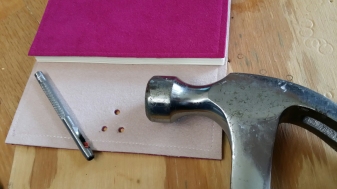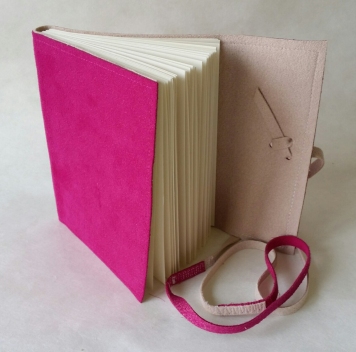I created one of my first handmade books on a summer trip when I ran out of space in the store-bought journal I had along. So, I improvised by constructing an emergency book out of hotel note paper, a store bag from a souvenir purchase, and the hotel sewing kit. That was 20 years ago. Here is an updated version of that now-historical experience. For research purposes (really, because it was fun and I wanted to) I made a found-materials book this morning while staying with a relative. This is how I did it– then and now — and you can, too!
Gather your supplies. This is fun. Be open to discovering or usurping supplies from wherever you encounter them.

I thought I’d recreate my experience of making a book with whatever I could find. At a relatives, I hunted around the phone desk drawers and home office area and found note pad papers and a push pin.
- Paper for pages: I have used papers such as the notepad next to the phone in a hotel room, receipts, and collected brochures. You could also us discarded documents from a business office’s recycle bin, uncolored pages from your child’s coloring book, anything with blank spaces for drawing or writing.
- A cover: something slightly heavier, from the packaging from your lunch, to a shopping bag, to the menu you “borrowed” from a restaurant, or the cover stock from that paperback you were going to leave in the hotel anyway.
- Needle: Doesn’t have to be an actual needle, just something that will allow you to get your thread or string-like substance through a hole.
- A pushpin: easily obtained from a random coffee shop bulletin board, or the junk drawer at your mother-in-law’s house.
- Thread or Cord: I was lucky enough to find a travel sewing-kit in my hotel room at that time. Since then, I’ve used the raffia off of a table decoration, the curly ribbon from a balloon centerpiece, and a shoelace.
- Scissors, if you can locate a pair. Otherwise, folding and tearing can be your friend, and can yield rustic results.

Left: After I folded all of the papers, I stacked them, forming my “paper taco.” Right: Used the pushpin to poke my thread, minty dental floss, through the holes I’d just poked.
How to Proceed. These are some general steps to follow. Feel free to improvise.

Left: After I sewed the pages together, I trimmed the excess cover paper to match the largest page size. Top Right: I used a glue stick to attach one of the note pages to the front, inside cover. Bottom Right: I found a business envelope in the recycling bin that I cut and glued into the back page where I inserted a blank index card.
Assess your paper situation. The pieces don’t necessarily have to be the same size. In fact, variation can add a little whimsy. Fold your collected papers in half and stack them together. These will be used for the inside of your book.
Make a cover out of the heavier found material. It should be the same size as your biggest piece of paper you are using for the inside pages. You might have to cut or tear the bag, packaging, cardboard, or whatever you found.
(Attempt to) fold your cover in half. This will be easy if it’s the material is not too heavy. Sometimes, you can take advantage of existing creases, like say, at the fold of a box corner. Or, in the case of the photo examples here, I used a blank greeting card.
Stack all of your papers together. Make a paper taco with the cover on the outside.
Now comes the dangerous part. Without drawing blood, poke two holes in the folded, inside edge of your stack. Leave at least ½” from the top and bottom of the book.
Gather your sewing material. If you’ve got something substantial, like raffia or ribbon, or a shoe lace with a plastic seal, you might be able to roll and poke the end through the hole you’ve made without a needle. If you have thread and needle, proceed as you would if you were sewing regularly. Double or quadrupling the thread for strength.
Assemble the book by sewing from the inside top hole to the outside of the book. Sew back into the other hole. You might repeat this several times depending on how much string you have, or how strong your cord is. In the case of dental floss (as per photo example) I sewed through twice.
Once you have both ends on the inside of the book, tie a firm square knot. You could also decide you want the knot to be on the outside spine of the book because it’s nice and decorative when the excess hangs down.
And, voila! You have a pamphlet book made from found materials ready for notes, musings, drawings, or storing small mementos.

The random, blank greeting card I found in a desk drawer worked well for the cover. This little, sturdy friend will travel in my purse as an idea book. I did it all while having my morning tea!
























